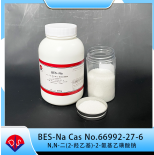- Category :
Other Chemicals/Others
- CAS NO : 66992-27-6
- EC NO :
- Molecular Formula : C6H14NNaO5S
- Main Specifications : White Powder
- Synonyms : BES sodium salt;sodium 2-[bis(2-hydroxyethyl)amino]ethanesulfonate;2-[bis(2-Hydroxyethyl)amino]-ethanesulfonic acid sodium salt;BES-Na;
Package: 500g/bottle
Uses : Biological buffer
Molecular Structure:

Product description:
BES sodium salt, also known as dihydroxyethyl aminoethanesulfonic acid, has a very similar structure to Bicine, except that aminoacetic acid is replaced with aminoethanesulfonic acid, which is often used as a pH regulator in various biochemical tests. Now let's focus on popularizing the production and use of BES sodium salts.
BES sodium salt production process:
1. Prepare to analyze pure raw materials such as diethanolamine, sodium 2-chloroethylsulfonate, and sodium hydroxide. Diethanolamine and sodium chloroethylsulfonate undergo a substitution reaction under the action of sodium hydroxide to generate BES.
2. After generating BES, add acid and acidification. According to a certain amount, add diethanolamine and sodium hydroxide to a four necked flask, with an equal amount of sodium hydroxide and sodium chloroethanesulfonate. The flask is equipped with a thermometer, pH meter, and stirrer.
3. After stabilizing the temperature, gradually add sodium 2-chloroethanesulfonate aqueous solution to the flask, paying attention to controlling the time and amount of addition. After completion, keep the temperature stable and continue the reaction for a period of time.
4. Based on the pH change of the system, the reaction endpoint is determined. After the reaction is completed, acid acidification is added, and vacuum distillation is carried out to remove excess water and unreacted diethanolamine. The crude BES product can be obtained by refining and drying the crude product.
Precautions for using BES sodium salt:
1. During the process of production or experimentation, pay attention to the sterilization treatment of containers, water, or other solutions used to avoid external interference with the experimental progress.
2. During the process of obtaining BES sodium salt powder after drying, operators should avoid direct contact and inhalation of dust, and relevant protective equipment can be worn.
3. Most of the BES sodium salts produced are in powder form, and solvents need to be prepared before use. However, it is important to prepare and use them immediately. Do not store the solution in large quantities for a long time as it is prone to bacterial growth.
 CN ChemNet > Gold Suppliers > Hubei new DE sheng material science and technology co., LTD. >
CN ChemNet > Gold Suppliers > Hubei new DE sheng material science and technology co., LTD. > 